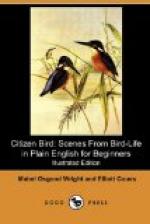“I know somebody whose feet are wet already!” said Nat, pointing to Olive, who was slipping about uncertainly.
“I know it was very foolish to come without my rubber boots, but they are so uncomfortable to wear in summer. Oh! please give me your hand—quick, father!” The Doctor caught her as she was sinking in what looked like a bit of good ground, but was really a bog tuft.
It took some time to work their way to the centre of the island. There the ground was drier in spots, between the little pools, and there were some high trees.
“Stop here,” said Olaf cautiously, “and look well before.”
They did so just as the crackling twigs startled some dusky shapes that flapped among the trees.
“The Herons!” exclaimed Rap, settling his crutch more firmly and preparing to watch closely.
As soon as their eyes became accustomed to the dim light, the party saw many large birds, some in the trees, some in the decaying underbrush, and others on the ground. Here and there among the trees were nests, looking like flat heaps of sticks. They were empty; but their sides, the trees, and the ground were all spattered and befouled with the chalky-white droppings of the careless colony. “Ugh!” shivered Dodo, who had a very keen nose, “what an ugly place to live in, and such a horrid smell! Please, uncle, don’t these birds have dreadful headaches very often?”
“I think House People would have wretched headaches if they lived here—in fact, we must not stay very long; but it agrees with Herons, who are built to be the wardens of just such places.”
“There are two kinds of Herons here,” said Rap. “Some black and white, with a topknot, and some striped brown ones. Aren’t the brown ones Bitterns? They look like one I saw in the miller’s woods, and he called it a Bittern.”
“The striped ones are the young birds, now wearing their first plumage. Bitterns prefer to live in freshwater meadows, or near ponds. They are solitary birds, keeping house in single pairs, and after nesting-time wander about entirely alone.”
“Isn’t it very hard to tell young Night Herons from Bitterns?” asked Nat.
“It would be easy for you to mistake them, but the habits of the two species are quite different. The Bittern nests on the ground, in a reedy bog, not in the woods, and may be seen flying in broad daylight, with his long legs trailing behind him. But in spite of this, he is a difficult bird to find; for if anything is ’remote, unfriendly, solitary, slow,’ it is the American Bittern, who often stands motionless among the reeds for hours.”
“That is just what the Bittern did that the miller and I saw,” said Rap. “We were hunting for a calf—the miller’s things are always straying away, because he never mends his fences—and this Bittern was among some very tall grasses and dry flags; for it was along in the fall, when things were turning brown. I don’t know how I ever came to see him; but when I did, he looked so queer that he almost scared me, and I said to the miller, ‘Whatever is that?’




